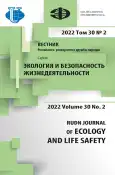Комплексная оценка родниковых вод Брянской области в системе государственного мониторинга
- Авторы: Соболева О.А.1, Анищенко Л.Н.1
-
Учреждения:
- Брянский государственный университет имени академика И.Г. Петровского
- Выпуск: Том 30, № 2 (2022)
- Страницы: 127-142
- Раздел: Экологический мониторинг
- URL: https://journal-vniispk.ru/2313-2310/article/view/323995
- DOI: https://doi.org/10.22363/2313-2310-2022-30-2-127-142
- ID: 323995
Цитировать
Полный текст
Аннотация
Представлены результаты эколого-химического и токсикологического анализа 20 модельных родников на территории городских и сельских поселений Брянской области в рамках водного мониторинга. Приведены показатели гидрохимии и фитотоксичности методом биотестирования. Родники классифицированы по температуре, дебиту, величине рН, значению минерализации и показателю «общая жесткость». Показаны корреляционные связи между полученными гидрохимическими показателями родниковых вод. Дополнения мониторинговой базы по состоянию родниковых вод в летнюю межень 2020 г. показали, что доминирующий поллютант вод в урочищах урботерриторий Брянской области - нитрат-ионы - превышают допустимые нормы показатели содержания общего железа. Среди модельных родников 25 % имеют превышение содержания нитрат-ионов относительно норм предельно допустимых концентраций (45 мг/л), 20 % - значительное превышение нормируемого показателя «железо общее» (0,3 мг/л). Расчет индекса фитотоксичности показал, что образцы воды двух родников - токсичны (коэффициент J > 20). Эколого-химический анализ родников и определение степени гемеробности урочища родников показали, что нитрат-ионы и хлорид-ионы являются индикаторными показателями антропогенного воздействия на природные воды. Сопряженный анализ показателей гидрохимии вод выявил сильные корреляционные зависимости между параметрами «общая минерализация - общая жесткость», «общая минерализация - хлорид-ионы», «электропроводность - хлорид-ионы», «электропроводность - общая жесткость», «электропроводность - общая минерализация». Проведено ранжирование родников по степени антропогенного преобразования ландшафта. По шкале гемеробности родниковые урочища классифицировали по семи степеням: метагемеробная (один родник), полигемеробная (два родника), α-эвгемеробная (два родника), β-эвгемеробная (один родник), мезогемеробная (шесть родников), олигогемеробная (восемь родников).
Об авторах
Ольга Александровна Соболева
Брянский государственный университет имени академика И.Г. Петровского
Email: OAsoboleva@bk.ru
ORCID iD: 0000-0001-7175-0763
аспирант кафедры географии, экологии, землеустройства
Российская Федерация, 241036, Брянск, Бежицкая ул., д. 14Лидия Николаевна Анищенко
Брянский государственный университет имени академика И.Г. Петровского
Автор, ответственный за переписку.
Email: eco_egf@mail.ru
ORCID iD: 0000-0003-4842-5174
доктор сельскохозяйственных наук, профессор, профессор кафедры географии, экологии, землеустройства
Российская Федерация, 241036, Брянск, Бежицкая ул., д. 14Список литературы
- Elpiner LI. Modern medical ecological aspects of theory of fresh groundwater resources. Hygiene and sanitation. 2015;94(6):39—46. (In Russ.)
- Fatbardh G. Study of chemical characteristics and pollution assessment of spring and well waters in a part of the Istog municipality (Kosovo). Sustainable Water Resources Management. 2018;4:399—414. doi: 10.1007/s40899-018-0248-2
- Rassadina YeV, Klimentova Ye G. Biodiagnostics and indication of soils. Ul’yanovsk: Ulyanovsk State University Publ.; 2016. 186 p.
- Lee LJ, Chen CH, Chang YY, Liou SH, Wang JD. An estimation of the health impact of groundwater pollution caused by dumping of chlorinated solvents. Science of the Total Environment. 2010;408(6):1271—1275. https://doi.org/10.1016/j.scitotenv.2009.12.036
- Lotter JT, Lacey SE, Lopez R, Socoy Set G, Khodadoust AP, Erdal S. Groundwater arsenic in Chimaltenango, Guatemala. Journal of Water and Health. 2014;12(3):533—542. https://doi.org/10.2166/ wh.2013.100
- Tshindane P, Mamba PP, Moss L, Swana UU, Moyo W, Motsa MM. The occurrence of natural organic matter in South African water treatment plants. Journal of Water Process Engineering. 2019;31:1008—1009. https://doi.org/10.1016/j.jwpe.2019.100809
- Williams DD. The spring as an interface between groundwater and lotic faunas and as a tool in assessing groundwater quality. International Association for Theoretical and Applied Limnology: Negotiations. 1991;24(3):1621—1624. https://doi.org/10.1080/03680770.1989.11899034
- Soldatenkov GI. The history of research on the recreational potential of the territory of the Republic of Belarus. Nature management problems and the environmental situation in European Russia and adjacent territories. 2019:174—181. (In Russ.)
- Lovinskaya AV, Kolumbayeva SZH, Suvorova MA, Iliyasova AI, Biyasheva ZM, Abilev SK. Complex study of potential toxicity and genotoxicity of water samples from natural sources of the suburban zone of Almaty. Genetic toxicology. 2019;17(2):69—81. https://doi.org/l0.17816/ecogen17269-81 (In Russ.)
- Kabirov RR, Sagitova AR, Sukhanova NV. Development and use of a multicomponent test system for evaluating the toxicity of soil in an urban territory. Russian Journal of Ecology. 1997;28(6):360—363. (In Russ.)
- Pospelova OA, Okrut SV, Stepanenko YeYe, Mandra YUA. Effect of functional areas of the city on a small river waters phitotoxicity. Proceedings of the Samara Scientific Center of the Russian Academy of Sciences. 2011;13(5—1):216—219. (In Russ.)
- Vaynert E, Val’ter R, Vettsel’ T, Yeger E, Klausnittser B, Klots S. Bioindication of pollution of terrestrial ecosystems. Shubert R, editor. Moscow: Mir Publ.; 1988. 348 p. (In Russ.)
- Dospekhov BA. Field experiment methodology (with the basics of statistical processing of research results). Moscow: Kniga po Trebovaniyu Publ.; 2012. 352 p. (In Russ.)
- Sokolova OYe, Potapova Ye V. Method of determining the hemerability of green areas. Bulletin of Zabaikalsky State University. 2018;24(3):26—31. (In Russ).
- Zanozin VV, Barmin AN, Valov MV. Studies of the degree of anthropogenic transformation of natural territorial complexes. Geology, Geography and Global Energy. 2019;4(75):168—183. (In Russ.)
- Guseva TV, editor. Hydrochemical indicators of the state of the environment: reference materials. Moscow: Forum: INFRA-M Publ.; 2010. 192 p. (In Russ).
- Vsevolozhsky VA. Fundamentals of Hydrogeology. Moscow: Publishing house of Moscow State University, 1991. 351 p. (In Russ.)
- Begday IV, Bondar’ YeV, Perekopskaya NYe. The research of the pollution of springs in the city of Stavropol by the method of factor analysis. Nauka. Innovatsii. Tekhnologii. 2016;2:77—88. (In Russ.)
- Yan S, Shubing L, Gu-Lin L, Xiaojuan G. Correlation analysis of the stability of groundwater quality in the Heihe river. StudNet. 2021;4(2).
- Soboleva OA, Anishchenko LN. On the issue of organizing regional natural monuments in landscape complexes of springs (Bryansk region, Non-Black Earth Region of the Russian Federation). Monitoring of the state of natural complexes and multi-year research in specially protected natural areas. 2019;3:99—105. (In Russ).
Дополнительные файлы









